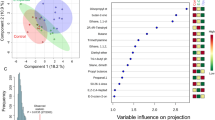Abstract
Objective: To assess dietary composition in relation to energetic status and ovarian function.
Design: An eight-month prospective study undertaken in 1989.
Setting: Ituri Forest, northeast Democratic Republic of Congo.
Subjects: Sixty-four female volunteers of reproductive age (16–45), with a subsample of 30 for nutritional focal follows, 39 for analysis of salivary progesterone levels, and 18 for analysis of salivary oestradiol.
Interventions: Regular anthropometric measurements of heights, weights, and mid-triceps skinfolds, 204 h of nutritional focal follows when all foods prepared and consumed were recorded and weighed, analysis of dietary composition using African food tables, collection of saliva samples every-other day for radioimmunoassay of salivary oestradiol and progesterone.
Results: The primary staple in the Lese diet is manioc, consumed at nearly every meal, but the diet is subject to seasonal fluctuations. Important seasonal crops are groundnuts and rice. Carbohydrates comprise 64% of the diet, protein 14% and fat 22%, but seasonal fluctuations in food items create significant differences in protein content (P=0.007). Energy intake falls by 25% in the hunger season. Lese energy balance reflects this lack with women losing a mean 7% of total body weight. The mean BMI for Lese women at the beginning of the study was 22.8 but, during the hunger season, the BMI for 20% of women fell to <18.5, indicative of chronic energy shortage. Mean levels of Lese salivary oestradiol and progesterone are chronically and significantly lower than healthy, Western controls (P=0.0001 for progesterone; P=0.03 for follicular values of oestradiol, P=0.0001 for mid-cycle values, and P=0.0002 for luteal values). Mean salivary progesterone levels were significantly lower for those Lese women losing weight (P=0.03), and significantly lower for weight-loss women when comparing levels at the beginning and end of the hunger season (P=0.03).
Discussion: The relatively low-fat, high-fibre diet of the Lese appears healthy, but there are occasional seasonal deficiencies in protein-energy and micronutrient content, especially for pregnant and lactating women. Dietary composition may affect Lese levels of reproductive steroids, partly explaining the chronically low salivary oestradiol profile of this population.
Sponsorship: This work was supported by a National Science Foundation Grant (BNS-88-10931) to PT Ellison, and a Royal Society Research Fellowship to GR Bentley.
This is a preview of subscription content, access via your institution
Access options
Subscribe to this journal
Receive 12 print issues and online access
$259.00 per year
only $21.58 per issue
Buy this article
- Purchase on Springer Link
- Instant access to full article PDF
Prices may be subject to local taxes which are calculated during checkout
Similar content being viewed by others
Author information
Authors and Affiliations
Rights and permissions
About this article
Cite this article
Bentley, G., Harrigan, A. & Ellison, P. Dietary composition and ovarian function among Lese horticulturalist women of the Ituri Forest, Democratic Republic of Congo. Eur J Clin Nutr 52, 261–270 (1998). https://doi.org/10.1038/sj.ejcn.1600547
Received:
Revised:
Accepted:
Published:
Issue Date:
DOI: https://doi.org/10.1038/sj.ejcn.1600547
Keywords
This article is cited by
-
Short-term and long-term mate preference in men and women in an Iranian population
Scientific Reports (2021)
-
Unravelling the role of epigenetics in reproductive adaptations to early-life environment
Nature Reviews Endocrinology (2020)
-
Seasonality of food groups and total energy intake: a systematic review and meta-analysis
European Journal of Clinical Nutrition (2016)
-
A Critical Test of the Waist-to-Hip Ratio Hypothesis of Women's Physical Attractiveness in Britain and Greece
Sex Roles (2006)


